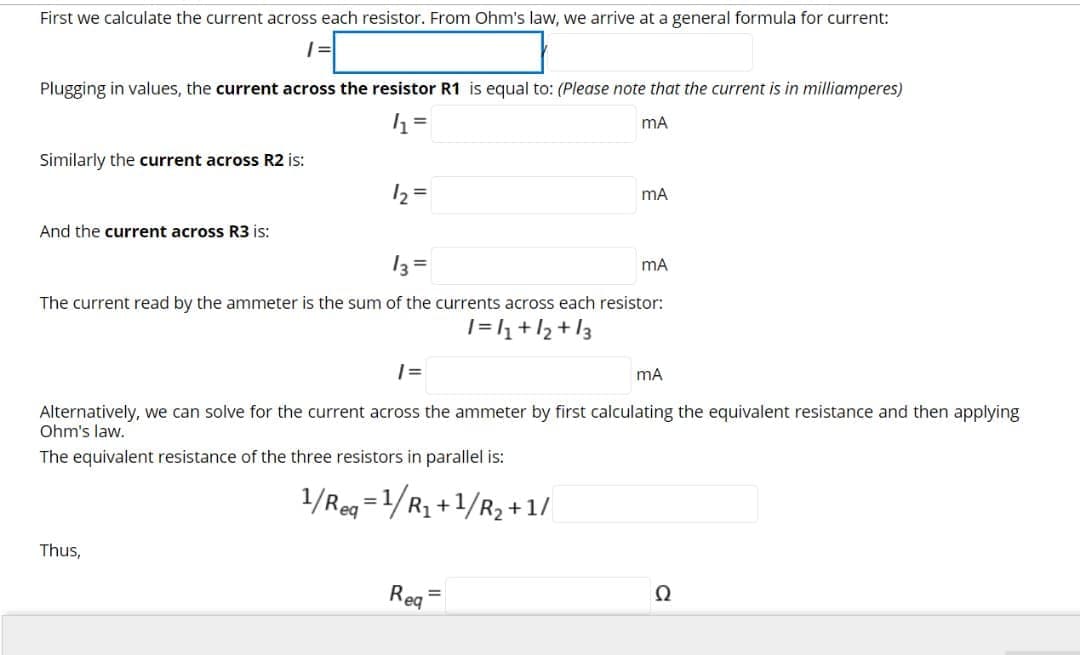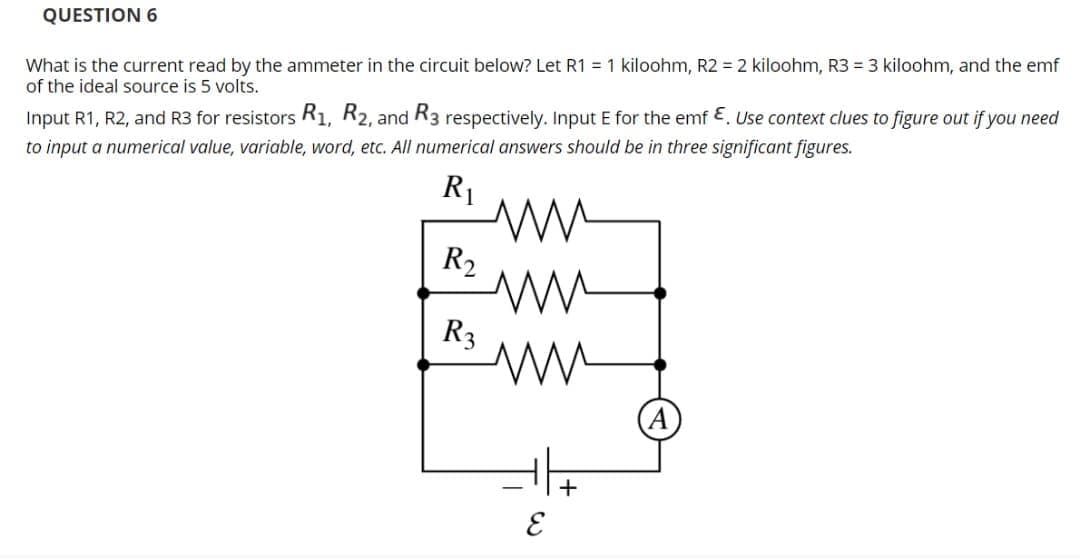First we calculate the current across each resistor. From Ohm's law, we arrive at a general formula for current: Plugging in values, the current across the resistor R1 is equal to: (Please note that the current is in milliamperes) mA Similarly the current across R2 is: 12 = mA And the current across R3 is: 13 = mA The current read by the ammeter is the sum of the currents across each resistor: 1=1+/2+13 | = mA Alternatively, we can solve for the current across the ammeter by first calculating the equivalent resistance and then applying Ohm's law. The equivalent resistance of the three resistors in parallel is: 1/Reg =1/R1+1/R2 +1/ Thus, Reg Ω
First we calculate the current across each resistor. From Ohm's law, we arrive at a general formula for current: Plugging in values, the current across the resistor R1 is equal to: (Please note that the current is in milliamperes) mA Similarly the current across R2 is: 12 = mA And the current across R3 is: 13 = mA The current read by the ammeter is the sum of the currents across each resistor: 1=1+/2+13 | = mA Alternatively, we can solve for the current across the ammeter by first calculating the equivalent resistance and then applying Ohm's law. The equivalent resistance of the three resistors in parallel is: 1/Reg =1/R1+1/R2 +1/ Thus, Reg Ω
Chapter10: Direct-current Circuits
Section: Chapter Questions
Problem 37P: Consider the circuits shown below, (a) What is the current through each resistor in part (a)? (b)...
Related questions
Question

Transcribed Image Text:First we calculate the current across each resistor. From Ohm's law, we arrive at a general formula for current:
Plugging in values, the current across the resistor R1 is equal to: (Please note that the current is in milliamperes)
mA
Similarly the current across R2 is:
12 =
mA
And the current across R3 is:
13 =
mA
The current read by the ammeter is the sum of the currents across each resistor:
|=l1+/2 +l3
| =
mA
Alternatively, we can solve for the current across the ammeter by first calculating the equivalent resistance and then applying
Ohm's law.
The equivalent resistance of the three resistors in parallel is:
1/Reg =1/R, +1/R2 + 1/
Thus,
Rea
Ω
%3D

Transcribed Image Text:QUESTION 6
What is the current read by the ammeter in the circuit below? Let R1 = 1 kiloohm, R2 = 2 kiloohm, R3 = 3 kiloohm, and the emf
of the ideal source is 5 volts.
Input R1, R2, and R3 for resistors R1, R2, and R3 respectively. Input E for the emf E. Use context clues to figure out if you need
to input a numerical value, variable, word, etc. All numerical answers should be in three significant figures.
R1
R2
R3
Expert Solution
This question has been solved!
Explore an expertly crafted, step-by-step solution for a thorough understanding of key concepts.
This is a popular solution!
Trending now
This is a popular solution!
Step by step
Solved in 4 steps

Knowledge Booster
Learn more about
Need a deep-dive on the concept behind this application? Look no further. Learn more about this topic, physics and related others by exploring similar questions and additional content below.Recommended textbooks for you


Glencoe Physics: Principles and Problems, Student…
Physics
ISBN:
9780078807213
Author:
Paul W. Zitzewitz
Publisher:
Glencoe/McGraw-Hill


Glencoe Physics: Principles and Problems, Student…
Physics
ISBN:
9780078807213
Author:
Paul W. Zitzewitz
Publisher:
Glencoe/McGraw-Hill